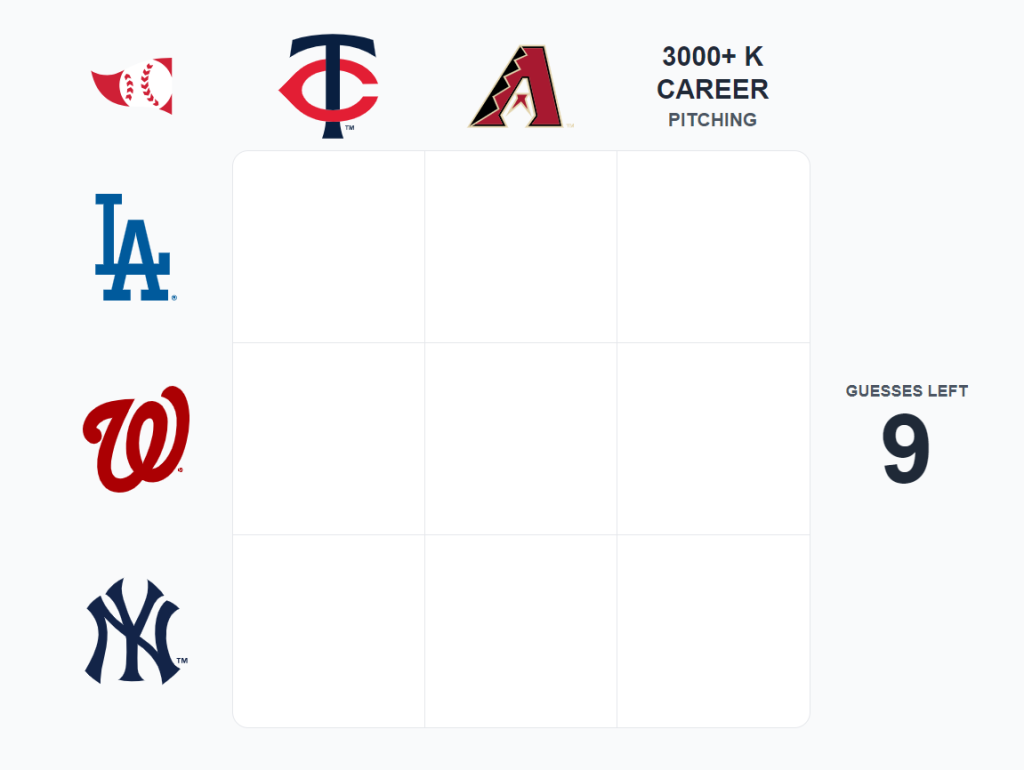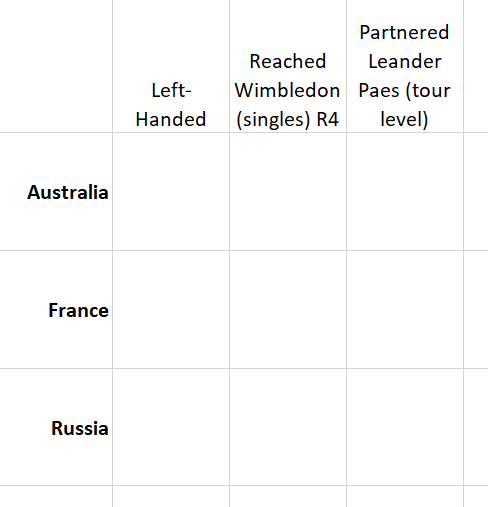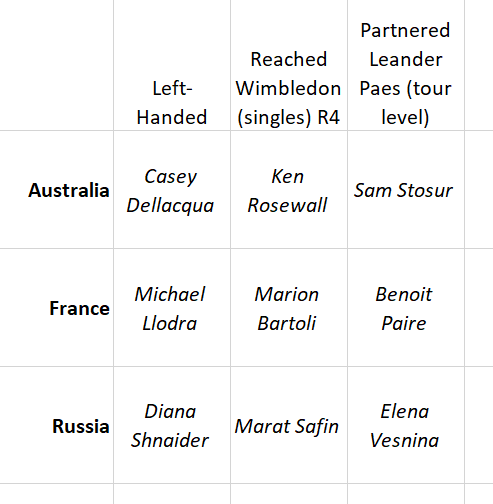If you’re a certain kind of baseball fan, you’ve already heard about the game Immaculate Grid. It’s a clever exercise in sports trivia, with a new puzzle posted each day. There are now daily football, basketball, and ice hockey games as well.
But no tennis. We’ll come back to that.
For the uninitiated, here’s how it works. This is today’s puzzle:
The icons defining the rows and columns are team logos. For each square, you need to think of a player who spent time with both teams–or has both attributes. The upper-left square will be someone who played for both the Dodgers and the Twins. The upper-right square needs to be someone who pitched for the Dodgers and recorded at least 3,000 strikeouts.
Simply thinking of names isn’t hard enough for some trivia buffs. Every correct answer comes with a “rarity score,” determined by how many other people chose the same player. The more uncommon your pick, the better.
A tennis grid?
The biggest obstacle to an Immaculate Grid for tennis is that we don’t really have teams. Yes, there’s World Team Tennis, and there are doubles teams, but it’s not the same thing.
A partial substitute would be nationality. That’s probably the closest analogue that tennis has to teams. It’s not a perfect replacement, though. Many players have appeared for both the Dodgers and Twins, but only a small number of tennis players have switched nationality. For many pairs of nations, there is no overlap at all.
One solution, then, is to use nationalities as rows and attributes as columns. By “attributes” I mean just about anything other than nationality. We could have columns for “left-handed,” “played Davis Cup singles,” “reached a Wimbledon fourth round,” “won a tour-level doubles title,” “partnered Leander Paes,” and so on. Attributes could define rows, as well; there’s no law that says all three rows must be nationalities.
So… what the hell. Here’s a tennis-themed grid to try. Active and retired players are all fair game, as are both men and women:
There are multiple answers for every square, but I’ve included one possible solution at the bottom of this post.
The tennis version of the game only works–as far as I can tell–by using more arcane attributes than the original baseball setup. For baseball, as well as the other sports now offered, four or five of the rows/columns are usually teams, and the remainder are very well-established accomplishments. Not only does tennis lack teams in the same sense, it also doesn’t have the same set of familiar career and single-season statistical records.
For tennis, then, human curation is likely essential. When I first generated a random list of three nations (weighted by how many players appear in my database), I ended up with Denmark, Israel, and Kazakhstan. Even apart from the fact that some of the squares would have no answer at all, some of the remaining ones would be awfully obscure. If you can come up with a Danish lefty off the top of your head, you’re a better fan than I am. Good trivia games require a careful mix of difficulty and solvability, and I suspect that getting the balance right would be much trickier for tennis than for the major American team sports.
The general solution
In thinking about adapting Immaculate Grid for tennis, I realized that the same general grid-building rules could apply to anything. Think of the answers as objects–usually people, but not necessarily–and the row/column labels as attributes.
Thus, an IG-style game could be constructed for any set of objects with attributes.
One example: Film actors. Attributes could be in the form of “starred in a movie alongside x” (think “Six Degrees of Kevin Bacon”) or “worked with director y” or “played famous character z.”
Another one, expanding the notion of “objects”: World cities. Attributes could be population size, whether it is a national capitol, where it is located (country or continent), that it has hosted an Olympiad or World’s Fair or other significant event, and so on.
So, for any topic, assuming you were armed with a database of objects and attributes, it would be easy to automatically generate grids. Not every randomly-generated grid of attributes would work. You’d have to avoid impossibilities, like the non-existence of a Danish player who partnered Leander Paes at tour level. The remaining problem to keep the game playable would be to avoid situations where answers exist, but they are below some threshold of obscurity.
Again, for baseball, that’s not really a problem. By using only the 30 MLB teams and a small set of famous accomplishments as attributes, every possible combination probably generates either (a) a large number of possible answers, or (b) a small number of notable answers. Yesterday, one of the squares was a Chicago White Sox pitcher who won the Cy Young Award. There are only three such players, but any Cy Young winner is relatively well-known.
One solution for tennis (or other non-baseball topics) would be to rate players (or objects) by notability. It doesn’t have to be fine-grained. For tennis, you could label any player with at least 100 tour-level matches “notable,” and everyone else “not notable.” If a row/column combination had only three possible answers, none of which were notable, you could treat it the same as an impossible combination and discard that grid. Perhaps three notable players or ten non-notable players would be enough to give gamers a fair shot; it would be up to you to determine the threshold.
If there’s ever going to be a (daily) Immaculate Grid for tennis, it won’t be run by me. But if you are so inclined, feel free to steal any of the ideas I’ve laid out here.
Finally, as promised, here’s one solution to my tennis grid above:
* * *
Subscribe to the blog to receive each new post by email:


